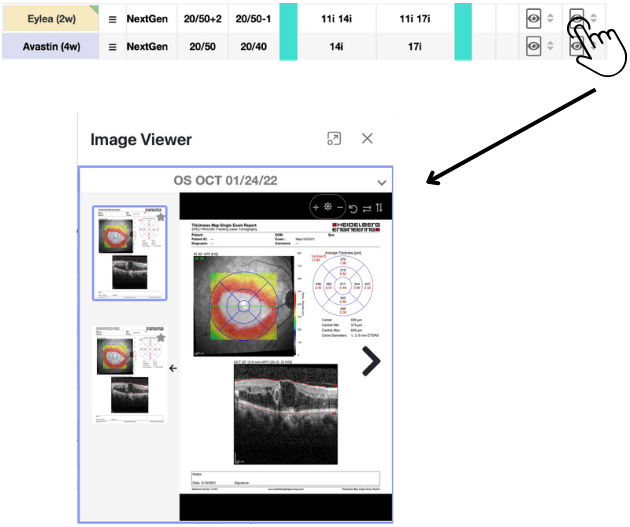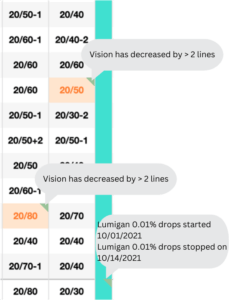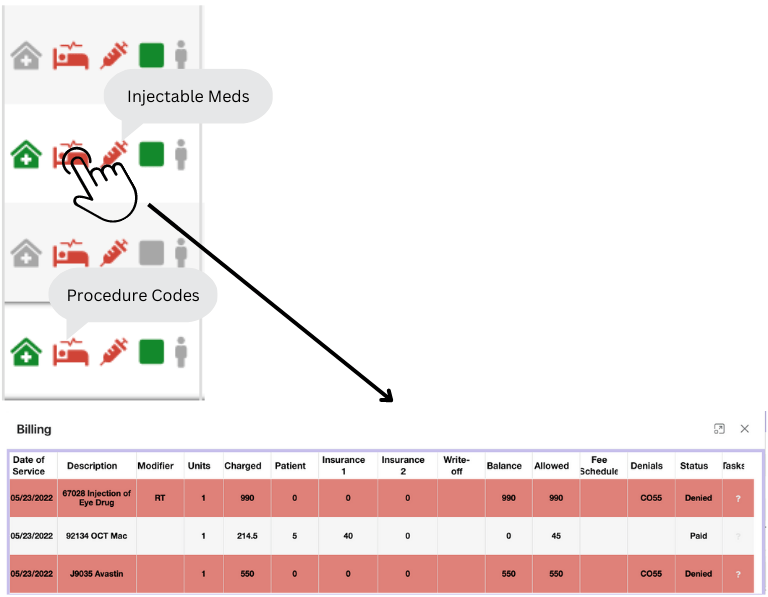Complex Retina Patient with Glaucoma Disease: Ryan Smith
A Case Study
Several areas of this complex retina patient’s history require specific attention. Ryan Smith is not a “simple” patient. There are missed appointments, possible compliance issues, and various revenue denials, all on top of the fact that while Ryan Smith is a retina patient, he also suffers from glaucoma, and his patient history was documented in two separate EHR systems.
To understand Ryan Smith’s complete story, doctors using most EHR systems must delve into various tabs and maneuver through several screens. DHRpro, an add-on technology for the provider’s current EHR, gathers Ryan Smith’s entire patient story and presents it on a single dashboard so that at Ryan Smith’s next visit, the physician can easily understand his complicated history in moments while receiving alerts on particularly notable points.
Getting To Know Ryan Smith

Smith is a 67-year-old male visiting for his usual 2x per month checkup. His primary insurance is Aetna, which covers his medication payments, and the physician can see Smith’s unpaid patient balance of $150, likely due to a co-pay. DHRpro also shows the referring doctor, Dr. Naomi Brown, and the chief complaint for the latest visit.
Appointment Statuses
DHRpro shows all of Smith’s visits in a longitudinal column until his last visit on 10/07/2022, including missed appointments. In 2022, Smith missed two follow-ups, one on 7/11/2022 and the second on 09/26/2022. He had canceled the first and the office the second.
In both instances, Smith returned to the office within two weeks but had he not, there could be a concern for reduced effectiveness of reoccurring injections and Glaucoma medications.

Complex Retina Patient's Injections and Procedures
Over 10 months, DHRpro shows 5 injections in Smith’s right and left eye. All these injections are shown side by side in longitudinal columns based on OD and OS. And the total injections per drug are summarized at the bottom of the dashboard.
In his right eye, Smith received three Eylea injections on 11/22/2021, 12/27/ 2022, and 01/24/2022. He then received two Avastin injections on 3/28/2022 and 5/23/2022. In Smith’s left eye, he received two injections of Avastin on 12/13/2020 and 01/10/2022, followed by Eylea on 01/24/2022, and two more injections of Avastin on 03/14/2022 and 05/09/2022.

Flagging a Potential Compliance Issue
Without knowing more about the patient, DHRpro alerts physicians of possible compliance issues, informing Smith’s doctor that there is a potential error with the injection log matching the associated bills on 1/24/2022.

If the alerts were red, physicians would know that injections had been administered too close together, but in this case, yellow indicates a clinical-billing mismatch. The physician can easily see that the problem stems from an Eylea injection in the left eye within two weeks of an Avastin injection in that same eye. A doctor is not even allowed to bill for the Eylea injection so soon after the previous injection. A doctor would only do so because the patient’s left eye became so bad that a more aggressive approach was necessary or because this is a fearful case of malpractice. To investigate this curiosity, the doctor can use DHRpro’s dashboard to dig into where things may have gone wrong.
On the same dashboard, the doctor can see that there was a procedure billed for the Eylea Sample in the right eye, but there was no injection billed, the gray injection icon indicating just that.
To begin investigating, the doctor can first look at their previous plan to see if they had explained any discrepancies.

Next, perhaps they determined the patient’s eye health had digressed so drastically that the Eylea injection in the left eye was necessary. In that case, the doctor can look at the patient’s vision. The patient’s left eye went from 20/40 to 20/50-1. With a vision that only lost one line, there seems to be only a minimal decline. But the doctor can check further by pulling up the OCT on the dashboard. In this case, the OCT, compared to its previous OCT, shows minimal decline too. The doctor then knows they did not administer the Eylea injection out of necessity.
All that is left to assume is that the Eylea Sample in the right eye was administered and billed, and there was likely a mistake with ordering the Eylea injection in the left eye or logging it incorrectly. Since it was not billed, there was no explanation in the plan, and the patient’s health had not fallen drastically, the doctor can assume something was documented or logged incorrectly in the left eye.
Data From Multiple EHRs

In Smith’s case, DHRpro grabs information from two separate EHR systems and presents it on the single-screen dashboard. Whether Smith switched providers, or his provider switched EMR systems, Smith has information from MDOffice and NextGen.

A Retina Patient with Glaucoma
DHRpro also shows the doctor that Smith has multiple diseases. Smith is particularly complicated since even though he is a retina patient treated with injections, he is on glaucoma medications as well. The retina doctor can know that this patient has glaucoma and needs to see a comprehensive ophthalmologist or a glaucoma specialist for glaucoma management. The doctor can help ensure the patient meets the necessary provider through a referral or within the same practice.
DHRpro shows all of Smith’s historical visions next to the medications administered. Therefore, his physician can easily see the correlation. DHRpro also creates alerts for any sudden historical decreases or uptakes, which, while not necessarily pertinent to today’s visit, is an important part of Smith’s patient history.

Customizable Alerts for Diagnostic Tests

DHRpro alerts the doctor to any diagnostic test they should choose. For example, if a doctor wants a visual field every two years, they can set DHRpro to alert them for that. In this case, the doctor chose to receive an alert for an ERG if one had never been done before on a diabetic patient. But those parameters are doctor specific and can be set for any diagnostic test.
Revenue Cycle Management – Addressing Denials
Finally, DHRpro shows that on the four appointments 3/14/2022, 3/28/2022, 05/09/2022, and 05/32/2022, the Avastin injection and the associated procedure were denied for CO55, the claim/service was denied because the procedure/treatment is deemed experimental or investigational by the payer.
Perhaps this could be resolved by submitting additional documentation proving the patient did require such medications, but Smith’s physician would need to involve the practice billers to know for sure. At the very least, Smith’s physician is alerted that a particular drug had been denied several times consecutively.

In Conclusion
DHRpro’s Retina Dashboard is everything you need on one screen. It not only makes your exams more efficient, but it also assists in delivering a better quality of care. So, with DHRpro by your side, you can be sure that the next time Ryan Smith steps into your office, you are providing him with the most thorough quality care possible.

